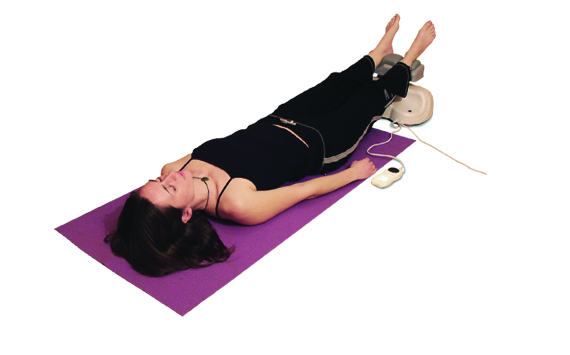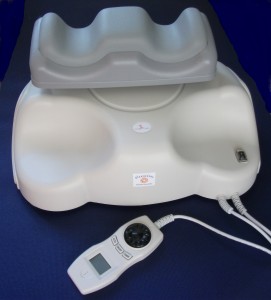How Does The Flexxicore Passive Exerciser Work?
Using the FlexxiCore is very simple. You simply lie down, place your legs in the cushioned recesses on the leg cradle, switch on using the remote hand controller, and adjust the speed as you wish. You can read an introduction to using it here.
This article in TalkBack, the magazine of the UK's National Back Care charity, summarises the story behind the FlexxiCore.
The FlexxiCore Passive Exerciser is the culmination of decades of therapeutic knowledge and experience. One branch of that knowledge originated in Japan – where ‘Goldfish Exercise’, as it is affectionately known by the Japanese, has a long history. The other historical roots lie in the West – more specifically in Canada where “Continuous Passive Motion” [CPM] equipment was invented in the 1970’s by a specialist in treating backs.
The Japanese concept of "Kingyo Undo" - Goldfish Exercise - has been used in Aikido and other Martial Arts for many years, starting long before the invention of the first exercise machine that simulates the same movement - see this short video by an Aikido Master: https://www.youtube.com/
Meanwhile, CPM equipment is used by osteopaths and other back care professionals to ease spinal problems by encouraging the flow of synovial fluid between the discs. This helps to reduce inflammation and ease pain by supplying nutrients and oxygen to the tissues, and helping to expel the toxins that arise from inflammation.
The oscillatory motion utilized by CPM mirrors some of the techniques used in therapies such as Shiatsu [Japan], Trager [USA] and the harmonic hands-on work of Osteopaths themselves. These manual techniques aim at releasing tension and inducing relaxation. Research has shown that the high incidence of back pain can be largely attributed to a chronic inability to relax, physically and/or mentally. Meanwhile a rocking motion is known to help synchronize brain waves and calm the nervous system.
The Japanese have been practicing “Goldfish Exercise” at least since the 1920s, both as an exercise form in traditional martial arts such as Aikido, and in therapies such as Shiatsu. The principle is to create an oscillating movement in the pelvis which simulates the elegant motion of a fish moving through water. The objective behind these techniques is to stimulate the body’s natural energy systems including deeper respiration and improved circulation, as well as facilitating release of stress and realignment of postural problems.
Then in 1990 a simple but ingenious energizing exercise machine was invented in Japan which gently swings your feet, making this invigorating exercise form more accessible for ordinary people to use at home. The first example of this Japanese technology was popularly called "The Chi Machine" when it was introduced to the West. The Sun Ancon Chi Machine is still in production over 25 years later. The FlexxiCore Passive Exerciser is an improved version of this technology with many more features and a Heavy-Duty motor. You can read more about the FlexxiCore's features here.
The FlexxiCore Passive Exerciser combines the invigorating and toning effects of the energizing exercisers invented by the Japanese with the therapeutic back care benefits of specialist CPM equipment – at a fraction of the cost. You just lie down, put your feet up, and let the FlexxiCore’s robust motor do all the work. An elegant and rhythmic wave of oscillating “goldfish” movement travels through your body, releasing tension and stress, while stimulating your body’s energy and circulatory systems.
For an introduction to using the FlexxiCore including a description of Your First Session, please click here.
To view our 7-minute video which shows the FlexxiCore in action, click here
For an explanation of the Features and Benefits, please click here.
To read some of the Stories and Statements of Appreciation from Users, including Health Care Professionals, please click here.
For a list of FAQs – Frequently Asked Questions – to go to the FAQ page, please click here.
For a list of Contraindications and Precautions, please click here.


